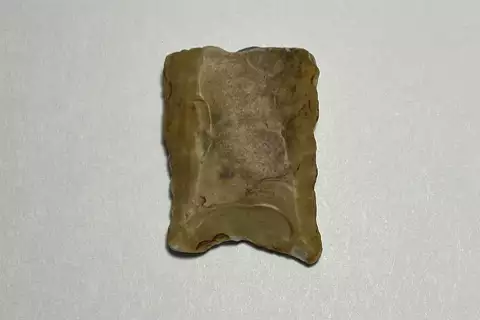Rare Archeological Find at High Island
By Max Roemer
High Island, located on the east end of the Bolivar Peninsula, is known for its archaeological significance due to its location on a barrier island that has been inhabited for thousands of years. High Island and Bolivar Peninsula has yielded evidence over the years of Paleoindian, Archaic, and later cultures, making it a rich source of information about past human activity across our area.
Daniel Sawyer, an avid beachcomber, drove 3 hours to search the beach near High Island’s “Lonely House” to look primarily for shark teeth this summer. Little did he know, his discovery would be far greater than any shark tooth or sea glass. Much to his amazement, Sawyer found a Clovis spear point.
Sawyer was curious as to what exactly he found, he turned to a beachcombing Facebook group where enthusiasts and amateur archaeologists post their discoveries like arrowheads and fossils. Sawyer said that he received “immediate” responses. Many said that his artifact looked like the base of a Clovis spear point crafted more than 12,000 years ago by the Paleoindian people.
“Well congratulations on the broke point, you’ve just guaranteed you’ll have plenty of company to help you find the other half,” one user joked. Dr. Aland Slade at the University of Texas Archaeological Research Laboratory at the University of Texas confirmed the finding and stated it does look like the basal section of a fluted Clovis point.
Clovis points are stone projectile tips, often spearheads, characterized by a distinctive groove, or “flute” running from the base. The channel of the spearhead likely helped attached the point to a shaft. This technology is considered a hallmark of early Paleoindian culture in North America dating back roughly 13,300 to 12,700 years ago.
The Clovis point spearhead was the first “universal” tool technology in North America. It doesn’t exist, to our current knowledge, in Hawaii and Alaska, it is most likely to be found in the continental United States. Erosion is a key factor in the earth revealing its ancient past. The Clovis point was first discovered in New Mexico in a place called Blackwater Draw.
Regardless of their massive historical importance, Clover points are rare, Dr. Slade states that, “In the grand scheme of things, they’re very rare.” And, he added, “A lot of archeologists I know who excavate Paleoindian deposits have never found a Clovis point. Collectors, private owners, beachcombers—they found quite a lot.”
Sawyer’s discovery is quite notable when considering its location. Reports of Clovis points from the upper Texas coast are extremely rare. The last known find in Galveston County goes back nearly 30 years to 1987. It was found on Crystal Beach. In this greater region of the Texas coastline, McFaddin beach of Jefferson County is rich in many artifacts from the Paleoindian era have been unearthed here.
Dr. Slade states, “A lot of academics originally thought all these points were coming down from different regions in Texas in the rivers…But, some of these points, some of them complete, they’re almost pristine…these are not being washed down a river for 200 miles.” Slade believes that many of the artifacts originated from now submerged land once above sea level during Paleoindian times, when the gulf coast shoreline extended much further out.
Jefferson County has had 150 points found in its boundaries. Chambers County has only had 1 found within our county. Hopefully, this article will inspire you to get outside and become a beachcomber. As evidence of Sawyer’s find, anyone can unearth a 12,000+ treasure!
Congratulations to Daniel Sawyer on his archaic find! It certainly gives one pause when considering man was walking our land 13,000 years ago. Thank you, Dr. Slade, as well.

While beachcombing along the Bolivar Peninsula, Daniel Sawyer stumbled upon an ancient Clovis spear point in the sand.